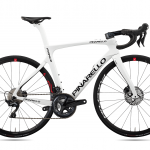
Cycling helmets are becoming crazier and crazier
But the one worn by Jonas Vingegaard may have been the last
March 6th, 2024
Usually cycling is seen as a heroic sport, all sweat and effort, and the images of Tadej Pogacar arriving at Piazza del Campo after 80km of escape to win the Strade Bianche confirm it. At the same time, cycling has always been a sport where technical innovation has progressed the relationship between man and machine in a perhaps more imperceptible and lateral way compared to other speed disciplines, such as motors, but equally effective. One of these transformations took place a short distance from the Sienese finish, in another race of the Italian spring, the Tirreno-Adriatico. On the occasion of the opening time trial along the roads of Lido di Camaiore, Jonas Vingegaard, two-time winner of the Tour de France and one of the most recognizable cyclists in the group, presented himself at the starting gate with an Aerohead II aerodynamic helmet from Giro Cycling that turned many heads. In fact, the new model made by the California-based leading company in the sector has moved the futuribility and memorability of cycling equipment one or two steps forward, turning riders into extras in a science fiction movie.
"It's really a dream to develop a helmet with Giro. It gives us confidence as a team to know that together we have created the fastest helmet possible. When I was a young cyclist, my idols wore Giro helmets: I can't believe it's now up to me," Vingegaard said reading the company's website. Wide base to cover almost the entire shoulders of the rider and huge frontal protrusion, which makes the head practically unrecognizable as enrolled in a giant triangle. The look is completed by a very wide integrated visor, to allow the cyclist to see forward even when bent in an aerodynamic position creating the Robocop effect that has set the web on fire. Obviously, there were immediate comments, with the cycling world for once managing to surpass the fence of enthusiasts and make even those who accidentally follow only the Giro d'Italia talk about it. But if the choice of Vismo-Lease, the team of Vingegaard, caused discussion, it was not the only one.
Other teams have experimented with helmets that could guarantee a competitive advantage in time trials such as the POC Tempor or the Sweet Protection Redeemer and the variety of head socks accompanied by the Specialized TT models. Each of these obviously struck for how it transformed the athletes into projectiles launched against the sound barrier, but it seems that this time Giro Cycling and Visma-Lease have gone too far. In fact, in addition to the countless jokes about the helmet's appearance, many have questioned how much such a design compromises the aesthetics of a sport that, as we said at the beginning, defines itself through the relationship between man and nature. And although progress in cycling is continuous and unstoppable, a certain romantic key must be maintained in its decline, at least this seems to be the point of view expressed by the UCI in a long statement that arrived a few hours later.
"Regarding the helmets produced by Giro Sport Design, Rudy Project, and Poc," - reads the note - "used by Visma|Lease a Bike, Bahrain Victorious, and several other teams, the UCI acknowledges that, although they may comply with the regulations, they raise a significant question about the design of helmets that focus more on performance than on their primary function, which is to ensure the safety of those who wear them." In fact, after already banning internal headphones from helmets as "non-essential" components starting April 2, the UCI is preparing to further tighten regulations regarding helmets that can be used in official races. A rule that for many will mean a return to a purer cycling, with riders who resemble more athletes than Imperial Guards of the Death Star, but on the other hand prevents companies and teams from working on the development of new technologies that could represent the future of the sport. Unfortunately or fortunately, we will no longer see these monstrous helmets on the heads of cyclists, which will remain confined to these early season races as prototypes of a possible future but still too far from the spirit of the discipline.
















